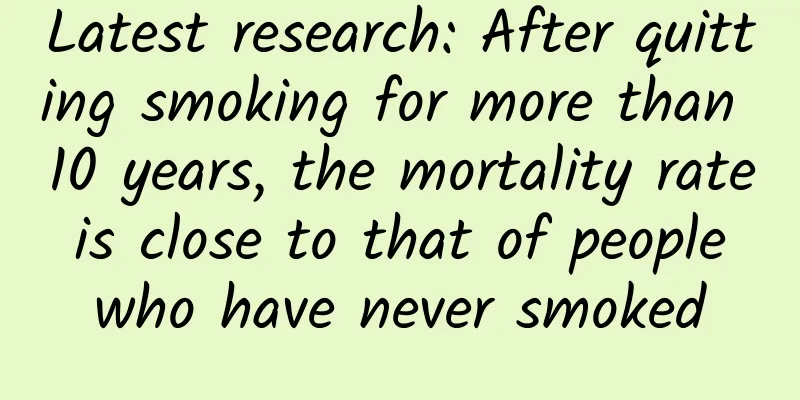Latest research: After quitting smoking for more than 10 years, the mortality rate is close to that of people who have never smoked

|
In recent years, with the popularization of health knowledge, not only has the concept of "smoking is harmful to health" been deeply rooted in people's minds, but the hazards of second-hand smoke and third-hand smoke have also gradually attracted everyone's attention. Relevant data show that in 2023, the number of smokers in my country exceeded 350 million, and the number of people exposed to passive smoking reached 740 million; more than 1 million people lost their lives each year due to tobacco. Of course, global data is not optimistic either. Smoking has become the main cause of premature death for all humans, causing 5 million to 7 million deaths each year. Smoking has many harmful effects! Let us first understand the harm of “first-hand smoke”. 1. Respiratory diseases: Smoking is a major risk factor for chronic bronchitis, emphysema, and chronic obstructive pulmonary disease. Long-term smokers are more likely to suffer from these diseases, which lead to breathing difficulties and persistent coughing. 2. Cardiovascular disease: Smoking is a major risk factor for heart disease and stroke. Chemicals in tobacco can damage the heart and blood vessels, leading to increased blood pressure, arrhythmias, and atherosclerosis. 3. Cancer: It is widely acknowledged that smoking causes cancer and is associated with a variety of cancers, including lung cancer, laryngeal cancer, oral cancer, esophageal cancer, stomach cancer, liver cancer, pancreatic cancer, kidney cancer, bladder cancer, and cervical cancer. The carcinogens in tobacco smoke can damage cell DNA and promote the development of cancer. 4. Impact on reproductive health: Smoking can damage the fertility of both men and women. Male smokers have reduced sperm count and quality, and female smokers are more likely to have problems such as irregular menstruation, infertility, and premature birth. 5. Impact on children: Pregnant women smoking increases the risk of miscarriage, premature birth and low birth weight. In addition, secondhand smoke (passive smoking) can also have a negative impact on children's health, including increasing the risk of bronchial asthma, respiratory infections and ear infections. 6. Skin problems: Smoking accelerates skin aging, leading to wrinkles and sagging skin. 7. Other health problems: Smoking is also associated with a variety of health problems such as osteoporosis, diabetes, gastric ulcers, cataracts and decreased cognitive function. As long as you don’t smoke, you won’t be affected? No! The harm of “second-hand smoke” and “third-hand smoke” should not be underestimated! Secondhand smoke refers to tobacco smoke exhaled by smokers during smoking and tobacco smoke emitted into the environment by burning cigarettes or other tobacco-containing products. It also contains a large amount of harmful substances. Non-smokers exposed to secondhand smoke will also increase the risk of smoking-related diseases (such as bronchial asthma, coronary atherosclerotic heart disease, lung cancer, etc.). Children with relatively low immunity are more vulnerable to the harm of secondhand smoke. Tobacco smoke can be absorbed by any object it touches, such as clothes, furniture, carpets, walls, and even hair and skin. The residual time can last for days, weeks, or even months. This "third-hand smoke" is even more difficult for non-smokers to guard against! If it accumulates for a long time, it will penetrate into the floor and walls and be difficult to remove! The harm to your family is continuous and long-lasting! Quitting smoking can significantly extend your life! Although everyone knows that smoking is harmful to health, quitting smoking is extremely difficult. Not only is the process of quitting smoking too painful, but the short-term effect on health is not significant, causing many smokers to give up halfway. However, a recent study published in NEJM Evidence has made the benefits of quitting smoking "tangible": 1. The sooner you quit smoking, the better. Data shows that if you can successfully quit smoking before the age of 40 and keep it off for about 3 years, the risk of death for women and men will be reduced by 95% and 90% respectively. 2. Quitting smoking for more than 10 years may "reverse" the harm of smoking. Regardless of the age of the smoker, compared with the old smokers who continue to smoke, quitting smoking for less than 3 years can avoid 5 years of life loss; and quitting smoking for 10 years or more can avoid about 10 years of life loss, making its mortality rate close to that of non-smokers. At the same time, the difference in excess mortality risk of quitting smoking at different ages and the survival rate after quitting smoking show that quitting before the age of 40 prolongs the survival age the most, which can extend the survival age by 12 years before the age of 80; followed by quitting smoking between the ages of 40 and 49, which can extend the survival age by about 6 years; quitting smoking between the ages of 50 and 59 can only extend the survival age by 2.5 years. In summary, quitting smoking is better than not quitting, and quitting early is better than quitting late. The study summarized the risk ratios of current or former smokers and never smokers from four national cohorts, including the United States, the United Kingdom, Norway, and Canada, and the subjects were adults aged 20 to 79 years from 1974 to 2018. During the 15-year follow-up of 1.48 million adults, a total of 122,697 deaths were recorded. The above conclusions were reached after adjusting for factors such as age, education, drinking, and obesity. Johns Hopkins University in the United States has conducted a related investigation and research on the impact of smoking on life expectancy. The results showed that the relative mortality rate of non-smokers was 12.1%, while the relative mortality rate of smokers was 33.1%, further confirming the negative impact of smoking on health. It is worth mentioning that smoking is more harmful to women, and the overall risk of death among female heavy smokers is slightly higher than that among men. Therefore, it is no exaggeration to say that it is never too late to quit smoking, and as long as you quit smoking, you can effectively reduce the mortality rate. This finding provides a strong impetus for those who are considering quitting smoking or are in the process of quitting smoking, and emphasizes the importance of public health policies in promoting smoking cessation and reducing the harm of smoking. |
<<: Irrational frog, obese bald crab... A list of humorous moments of scientists throughout history
>>: Milk cartons are 100% recyclable and the recycling method is unexpected
Recommend
Suifenhe's epidemic prevention risk level has been lowered to low risk, and efforts are being made to restore normal production and living order
The reporter learned from the Heilongjiang Provin...
Analysis and Extension of Java Dynamic Proxy Mechanism
introduction The emergence of Java dynamic proxy ...
The end of live show monetization?
Regulators take measures to regulate live broadca...
Is drinking yogurt every day good for your health? You will never guess the answer
"Yogurt is a healthy drink. Drinking more of...
Zhihu account anti-ban rules and product promotion guidelines!
1. My experience of selling products on Zhihu, fr...
If you want to use iPhone 7 in winter, you have to be careful with the Home button
The new generation of iPhone 7 has caused a lot of...
One-minute science | Why do plants in the desert grow in such strange shapes?
What are desert plants? Desert plants generally r...
The 16GB iPad only has half the available space
As applications and multimedia content take up mo...
Why did a nanomaterial researcher spark a passion for track cycling?
In track cycling, what have nanoscientists done t...
Has the secret of crop circles been solved long ago?
If you see strange patterns in a wheat field, you...
Should you turn on iOS privacy tracking? You will understand after reading this
The official version of iOS14.5 has been released...
Nothing new under the dome? Why not look at the tech startup boom under the haze?
December 21st was the sixth day after Beijing lau...
Lard residue is not really that bad.
When it comes to mouth-watering childhood memorie...
New Brand Content Marketing Tips!
Content marketing has always been the focus of br...
Detailed explanation of JSPatch implementation principle: Let JS call/replace any OC method
JSPatch is a small-sized JavaScript library that ...









